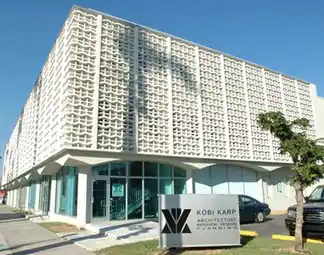
Miami Modernist architecture, or MiMo, is a regional style of architecture that developed in South Florida during the post-war period. The style was internationally recognized as a regionalist response to the International Style. It can be seen in most of the larger Miami and Miami Beach resorts built after the Great Depression. Because MiMo styling was not just a response to international architectural movements but also to client demands, themes of glamour, fun, and material excess were added to otherwise stark, minimalist, and efficient styles of the era. The style can be most observed today in Middle and Upper Miami Beach along Collins Avenue, as well as along the Biscayne Boulevard corridor starting from around Midtown, through the Design District and into the Upper Eastside.
The term MiMo has only recently been associated with the style. Popularity of the term is credited to Miami Beach resident Randall C. Robinson and interior designer Teri D'Amico. Principal examples of MiMo include the Fontainebleau Hotel, Eden Roc, Seacoast Towers, Deauville, and Di Lido hotels by famed architect Morris Lapidus; Norman Giller's Carillon Hotel, which was voted Miami Beach's "Hotel of the Year" in 1959; and the original Diplomat Hotel in Hollywood, Florida.
To some degree, Miami developed the style through the work of younger architects immediately after the war; they were more closely aligned with media promotions and sensationalism than older architects of the era. The region successfully transposed its extravagant resort styling to a national audience easily captivated by the area’s relative exoticism.[2]
The area along Biscayne Boulevard is now the designated "MiMo Biscayne Boulevard Historic District" or more uniquely named "MiMo on BiBo", for "Miami Modern on Biscayne Boulevard". MiMo Historic District runs roughly from 50th Street to 77th Street along Biscayne Boulevard, although MiMo can be found in the Design District and Midtown. Many annual festivals are held to promote MiMo architecture, such as "Cinco de MiMo" a play on "Cinco de Mayo" in early May. The area is bounded by the Little River to the north, Bay Point Estates to the south, the Florida East Coast Railway to the west, and Biscayne Bay to the east.[3]
Gallery
 Kobi Karp offices along Miami's Biscayne Boulevard
Kobi Karp offices along Miami's Biscayne Boulevard MiMo architectural follies on Lincoln Road
MiMo architectural follies on Lincoln Road Restaurant in the MiMo District
Restaurant in the MiMo District
Partial list of MiMo buildings
- Coral Sea Towers (Carlos B. Schoeppl, 1956) - 10300 W Bay Harbor Drive, Bay Harbor Islands
- Pepsi-Cola Bottling Pavilion (Daverman & Associates c: 1965) – 7777 NW 41st Street
- Biscayne Plaza Shopping Center (Robert Fitch Smith, 1953) – 7900 Biscayne Boulevard
- Dupont Plaza Center (Petersen & Shuflin, 1957) – 300 Biscayne Boulevard Way (demolished in 2004 to give way to the EPIC Miami Residences and Hotel).[4]
- Gold Dust, 7700 Biscayne Blvd
- Miami Herald (Naess & Murphy, 1960) – One Herald Plaza (Demolished Aug 2014 – Feb 2015)
- New Yorker Boutique Hotel (Norman Giller, 1953) – 6500 Biscayne Boulevard
- Shalimar Motel (Edwin Reeder, 1950) – 6200 Biscayne Boulevard
- Sinbad Motel (1953) – 6150 Biscayne Boulevard
- South Pacific Motel (1953) – 6300 Biscayne Boulevard
- Temple Menorah
- Thunderbird Motel (Norman Giller, 1955) – 18401 Collins Avenue
- Union Planters Bank (Francis Hoffman, 1958) – 1133 Normandy Drive
- Vagabond Motel (Robert Swartburg, 1953) – 7301 Biscayne Boulevard[5][6] (Reopened as the Vagabond Hotel in 2013)[7]
- The Creek South Beach Motel (Originally Ankara Motel) (Reiff & Feldman, 1954) – 2360 Collins Avenue
- Crystal House (Morris Lapidus, 1960) – 5055 Collins Avenue
- Deco Palm Apartments (Gilbert Fein, 1958) – 6930 Rue Versailles
- Deauville Beach Resort, (demolished in 2022)
- Imperial House (Melvin Grossman, 1963) – 5255 Collins Avenue
- International Inn (Melvin Grossman, 1956) – 2301 Normandy Drive, Normandy Isle
- Jackie Gleason House (Lester Avery, 1959) – 2232 Alton Road
- Lincoln Road Mall (Morris Lapidus, 1960)
- Miami Beach Bandshell (1961 by Norman Giller and Associates) 7275 Collins Ave - North Beach, Miami Beach
- King Cole Condominium (Melvin Grossman, 1961) – 900 Bay Dr.
- Royal York Hotel (1950), 5875 Collins Avenue (demolished prior to 2004)[8][9]
See also
References
- ↑ Wynwood Art District boundary map
- ↑ "Behind South Florida's MiMo Design Scene," by William H. Arthur. – Retrieved March 29, 2015
- ↑ District neighborhood, detailed profile
- ↑ Mayor Manny Diaz & Commissioner Johnny Winton To Personally Complete The Demolition Of Dupont Plaza Archived 2008-12-04 at the Wayback Machine – Retrieved January 13, 2007
- ↑ MiMo: Miami Modern Revealed by Eric P Nash & Randall Robinson Jr (2004)
- ↑ Vagabond Motel at Florida Architecture: 100 Years, 100 Places
- ↑ The Vagabond Hotel
- ↑ Kleinberg, Howard (December 2005). "Hotel Openings". Miami Beach City Clerk. p. 8. Retrieved March 1, 2021.
- ↑ Goodnough, Abby (May 16, 2004). "Push to Make Old Buildings Cool Again in Miami Beach". The New York Times. ISSN 0362-4331. Retrieved March 1, 2021.
External links
- Vagabond Motel (Robert Swartburg, 1953)
- MiMo Historic District
- Miami Beach USA Article on MiMO Architecture with photos.
- Wides-Munoz, Laura (AP), Offbeat Miami: the Miami Modern District or MiMo, on ABC News Travel